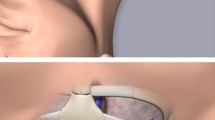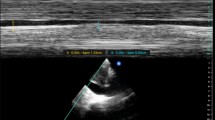Abstract
The aim of this randomized controlled study was to compare ultrasound-guided procedure with the Seldinger’s technique for placement of implantable venous ports. A total of 214 patients were randomized to receive TIAP placement by either ultrasound-guided procedure or the Seldinger’s technique. Complications and pain perception were compared between these two groups. No severe perioperative or periinterventional complication occurred. Significantly (P < 0.05) lower pain perception was observed in the ultrasound-guided group. Seldinger’s technique group showed higher rate in incidence of early and late complications including catheter dislocation, catheter occlusion, venous thrombosis, fever of unknown origin, skin necrosis, and sepsis. In conclusion, both techniques, the TIAP implantation via ultrasound-guided jugular vein puncture and via Seldinger’s technique subclavian vein puncture, are feasible and safe. Regarding intrainterventional pain perception and implantation-related complications, the jugular vein puncture under ultrasound guidance seems to be advantageous.
Similar content being viewed by others
References
Bow, E. J., Kilpatrick, M. G., & Clinch, J. J. (1999). Totally implantable venous access ports systems for patients receiving chemotherapy for solid tissue malignancies: A randomized controlled clinical trial examining the safety, efficacy, costs, and impact on quality of life. Journal of Clinical Oncology, 17(4), 1267.
Niederhuber, J. E., et al. (1982). Totally implanted venous and arterial access system to replace external catheters in cancer treatment. Surgery, 92(4), 706–712.
Plumhans, C., Mahnken, A. H., Ocklenburg, C., Keil, S., Behrendt, F. F., Günther, R. W., et al. (2011). Jugular versus subclavian totally implantable access ports: Catheter position, complications and intrainterventional pain perception. European Journal of Radiology, 79(3), 338–342.
Teichgräber, U. M., et al. (2011). Outcome analysis in 3,160 implantations of radiologically guided placements of totally implantable central venous port systems. European Radiology, 21(6), 1224–1232.
Seldinger, S. I. (1953). Catheter replacement of the needle in percutaneous arteriography; a new technique. Acta Radiologica, 39(5), 368–376.
Nocito, A., et al. (2009). Randomized clinical trial comparing venous cutdown with the Seldinger technique for placement of implantable venous access ports. British Journal of Surgery, 96(10), 1129–1134.
Johansson, E., et al. (2009). Patients’ perceptions of having a central venous catheter or a totally implantable subcutaneous port system–results from a randomised study in acute leukaemia. Supportive Care in Cancer, 17(2), 137–143.
Maki, D. G., Kluger, D. M., & Crnich, C. J. (2006). The risk of bloodstream infection in adults with different intravascular devices: A systematic review of 200 published prospective studies. Mayo Clinic Proceedings, 81(9), 1159–1171.
Carde, P., et al. (1989). Classical external indwelling central venous catheter versus totally implanted venous access systems for chemotherapy administration: A randomized trial in 100 patients with solid tumors. European Journal of Cancer and Clinical Oncology, 25(6), 939–944.
Mueller, B. U., et al. (1992). A prospective randomized trial comparing the infectious and noninfectious complications of an externalized catheter versus a subcutaneously implanted device in cancer patients. Journal of Clinical Oncology, 10(12), 1943–1948.
Hooda, B., et al. (2008). Implantable port devices are catheters of choice for administration of chemotherapy in pediatric oncology patients-a clinical experience in Pakistan. Annals of the New York Academy of Sciences, 1138, 43–46.
Povoski, S. P. (2000). A prospective analysis of the cephalic vein cutdown approach for chronic indwelling central venous access in 100 consecutive cancer patients. Annals of Surgical Oncology, 7(7), 496–502.
Silberzweig, J. E., et al. (2000). Reporting standards for central venous access. Technology Assessment Committee. Journal of Vascular and Interventional Radiology, 11(3), 391–400.
Gebauer, B., et al. (2009). Combined ultrasound and fluoroscopy guided port catheter implantation–high success and low complication rate. European Journal of Radiology, 69(3), 517–522.
Teichgräber, U. K., et al. (2003). Central venous access catheters: Radiological management of complications. Cardiovascular and Interventional Radiology, 26(4), 321–333.
Hind, D., et al. (2003). Ultrasonic locating devices for central venous cannulation: Meta-analysis. British Medical Journal, 327(7411), 361.
Biffi, R., et al. (2009). Best choice of central venous insertion site for the prevention of catheter-related complications in adult patients who need cancer therapy: A randomized trial. Annals of Oncology, 20(5), 935–940.
Di Carlo, I., et al. (2010). Increased use of percutaneous technique for totally implantable venous access devices. Is it real progress? A 27-year comprehensive review on early complications. Annals of Surgical Oncology, 17(6), 1649–1656.
Karakitsos, D., et al. (2006). Real-time ultrasound-guided catheterisation of the internal jugular vein: A prospective comparison with the landmark technique in critical care patients. Critical Care, 10(6), R162.
Nelson, B. E., et al. (1994). Experience with the intravenous totally implanted port in patients with gynecologic malignancies. Gynecologic Oncology, 53(1), 98–102.
Harvey, W. H., et al. (1989). A prospective evaluation of the Port-A-Cath implantable venous access system in chronically ill adults and children. Surgery, Gynecology & Obstetrics, 169(6), 495–500.
Keum, D. Y., Kim, J. B., & Chae, M. C. (2013). Safety of a totally implantable central venous port system with percutaneous subclavian vein access. Korean Journal of Thoracic and Cardiovascular Surgery, 46(3), 202–207.
Behrendt, F. F., et al. (2006). Evaluation of catheter loops in central venous port systems. Investigative Radiology, 41(11), 777–780.
Caers, J., et al. (2005). Catheter tip position as a risk factor for thrombosis associated with the use of subcutaneous infusion ports. Supportive Care in Cancer, 13(5), 325–331.
Cil, B. E., et al. (2006). Subcutaneous venous port implantation in adult patients: A single center experience. Diagnostic and Interventional Radiology, 12(2), 93–98.
Lorch, H., et al. (2001). Central venous access ports placed by interventional radiologists: Experience with 125 consecutive patients. Cardiovascular and Interventional Radiology, 24(3), 180–184.
Funaki, B., et al. (1997). Radiologic placement of subcutaneous infusion chest ports for long-term central venous access. American Journal of Roentgenology, 169(5), 1431–1434.
Yip, D., & Funaki, B. (2002). Subcutaneous chest ports via the internal jugular vein. A retrospective study of 117 oncology patients. Acta Radiologica, 43(4), 371–375.
Strum, S., et al. (1986). Improved methods for venous access: The Port-A-Cath, a totally implanted catheter system. Journal of Clinical Oncology, 4(4), 596–603.
Kock, H. J., et al. (1998). Implantable vascular access systems: Experience in 1,500 patients with totally implanted central venous port systems. World Journal of Surgery, 22(1), 12–16.
Author information
Authors and Affiliations
Corresponding author
Rights and permissions
About this article
Cite this article
Miao, J., Ji, L., Lu, J. et al. Randomized Clinical Trial Comparing Ultrasound-Guided Procedure with the Seldinger’s Technique for Placement of Implantable Venous Ports. Cell Biochem Biophys 70, 559–563 (2014). https://doi.org/10.1007/s12013-014-9956-x
Published:
Issue Date:
DOI: https://doi.org/10.1007/s12013-014-9956-x




